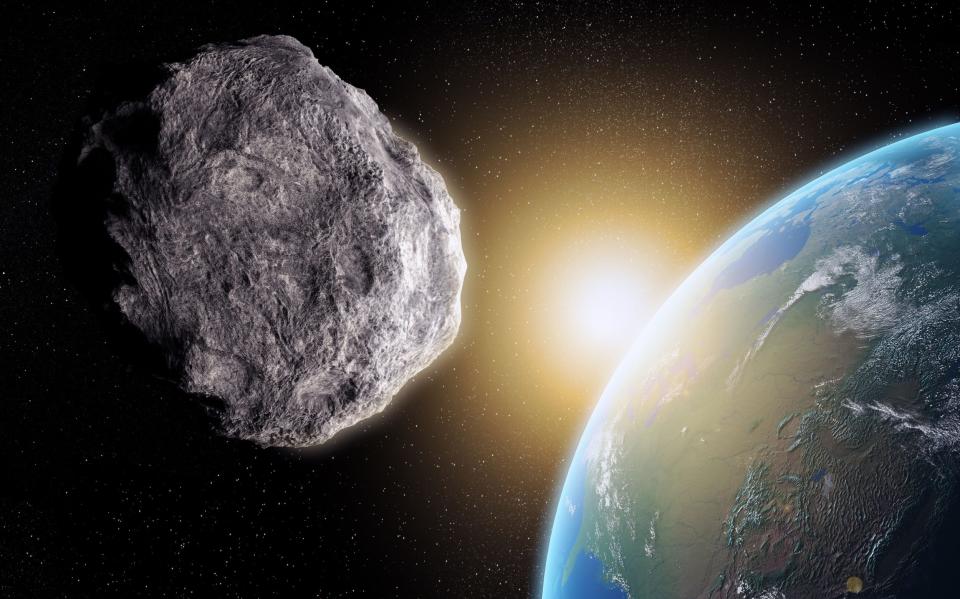Asteroids could be approaching Earth undetected, as Nasa finds danger zone

Astronomers have identified a danger zone from which potentially devastating asteroids can “sneak up” on Earth undetected.
The Nasa-funded scientists found that celestial objects approaching from the east in the night-time sky can appear stationary due to a quirk of the Earth’s daily rotation and its journey around the sun.
It means they are not detected by the network of computerised telescopes intended to look out for such threats.
The research took place after the astronomical community was shaken in 2019 by a “near miss”, which saw an asteroid approximately 100 metres across hurtle past Earth at a distance of only 70,000 km.
It was spotted just 24 hours previously.
The US Congress has set Nasa the task of identifying 90 per cent of asteroids 140 metres across or larger, a size which could devastate a region the size of a large city or small state if it hit land.
The agency is also developing methods to prevent Earth impacts.
Last year it launched an experimental mission to smash a heavy spaceship into the moonlet of a comet to see if doing so will knock it off course.
The new discovery comes amid a renewal of public interest in planetary collision in the wake of the hit Netflix film Don’t Look Up, which features Leonardo DiCaprio and Jennifer Lawrence as scientists trying to warn an unreceptive public about a comet that goes on to wipe out mankind.

Professor Richard Wainscoat, who led the research team at the University of Hawaii, said people “shouldn’t lose sleep” over the chances of being hit by a devastating asteroid.
But he added: “In the event that we find something that is going to hit the earth we would like to do something about it.
“It’s not a matter of finding them and sitting there and letting it hit.”
The algorithms governing the observation telescopes on the lookout for asteroids are programmed to flag up moving objects, to avoid wrongly identifying phenomena like supernovas and flare stars.
These take account of the fact that objects approaching Earth appear to drift west in the sky because of the Earth’s eastward spin on its axis.
However, when asteroids approach Earth from a portion of the eastern sky - roughly speaking, the patch that can be seen by looking directly up at around 2am - the planet’s spin and its curved orbit around the sun can make the objects appear stationary.
Published in the journal Icarus, the study states that 50 per cent of impactors approaching Earth from the east can be expected to undergo periods of slow motion that may make them difficult to detect.
Were it not for the phenomenon, asteroids of the size of the 2019 body, known as 2019 OK, would be detectable up to four weeks ahead of impact.
The team conclude: “Surveys should take extra care when surveying the sky in this direction, and aggressively follow up new slow-moving objects.”
'Way to go' on asteroid catalogue project
Professor Wainscoat said it should be possible to update the algorithms to overcome the apparent stationary effect.
The 2019 OK 100-metre asteroid was the largest currently known object of such a size passing by Earth within 70,000 km since 1908.
Nasa characterises near-Earth objects (NEOs) as those that come within 28 million miles of Earth’s path around the sun.
In 1994, Congress tasked the agency with cataloguing potentially hazardous NEOs larger than one kilometre.
In 2005, Congress updated the direction, tasking Nasa to find at least 90 per cent of potentially hazardous NEOs sized 140 metres or larger by the end of 2020.
Professor Wainscoat said that approximately 40 per cent of such objects had currently been catalogued.
“We’ve got a way to go,” he said.
“Once we have catalogued more than 90 per cent, the number that can creep up on us from this direction will be small.”
Plan to crash spacecraft into asteroid
Launched from Vandenberg Space Force Base in California in November, Nasa’s Double Asteroid Redirection Test (Dart) mission is the first trial of a so-called kinetic impactor technique to change the motion of an asteroid in space.
Scientists will aim to crash the spacecraft into a moonlet of about 160 metres orbiting around the near-Earth asteroid Didymos, which is approximately 780 metres.
In 2019, Nasa spent approximately $150 million on planetary defence programmes, 40 times more than a decade before.

 Yahoo News
Yahoo News 